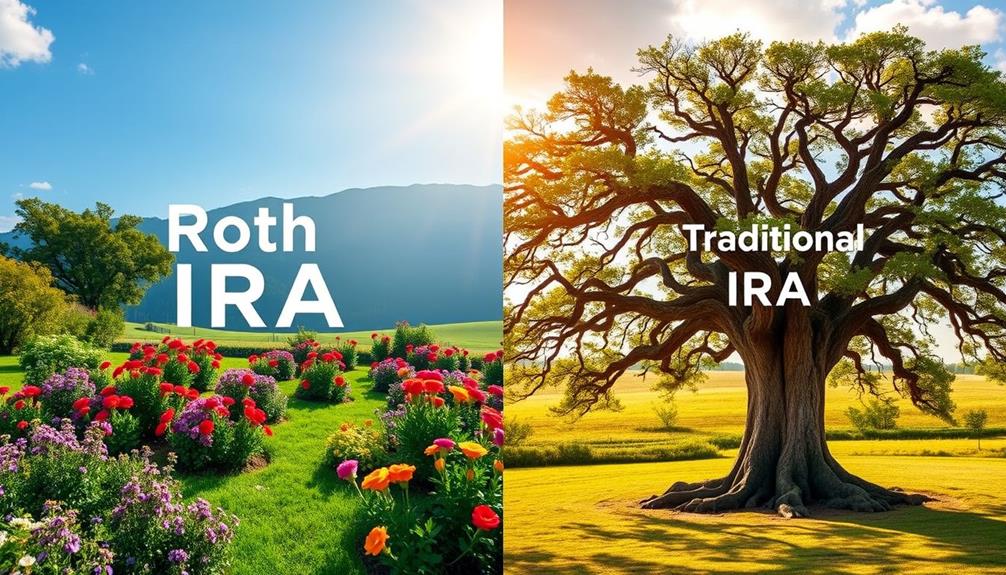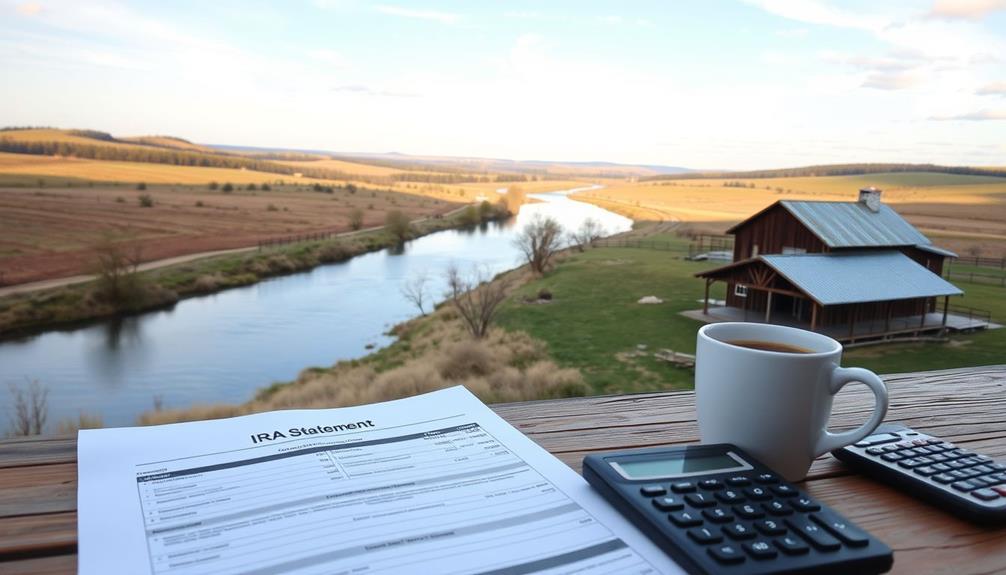The bucket strategy segments your retirement assets into three distinct categories: short-term, medium-term, and long-term. This approach guarantees you have immediate cash for expenses while also allowing for growth. You’ll safeguard yourself from market fluctuations and avoid selling investments at a loss. By regularly adjusting and monitoring your buckets, you can tailor your financial strategy to your needs. Explore more to uncover how to implement this effective retirement planning method successfully.
Key Takeaways
- The Bucket Strategy segments retirement assets into short-term, medium-term, and long-term buckets to ensure financial stability.
- Bucket 1 provides immediate access to cash for 1–5 years of expenses, protecting against market fluctuations.
- Bucket 2 focuses on income-producing assets for 5–10 years, balancing risk and returns for mid-term needs.
- Bucket 3 targets long-term growth through investments like stocks, preserving purchasing power for future expenses.
- Regular monitoring and rebalancing of the buckets is essential to adapt to changing needs and market conditions.
Understanding the Bucket Strategy

When you think about retirement planning, understanding the Bucket Strategy can be a game-changer. This approach divides your retirement savings into distinct “buckets” based on when you’ll need the money and your risk tolerance. The primary goal is to protect your immediate expenses from market fluctuations, ensuring you don’t have to sell long-term investments during downturns. By allocating funds appropriately, you can mitigate the sequence-of-returns risk, which often plagues retirees. You’ll find that this method not only offers peace of mind but also allows you to tailor your plan to fit your unique financial situation. Ultimately, the Bucket Strategy simplifies your retirement spending, making it easier to navigate your financial future with confidence. Additionally, utilizing seasonal recommendations can help you make informed decisions about when to allocate your funds for optimal growth.
The Three-Bucket Approach Explained

The Three-Bucket Approach offers a structured way to manage your retirement savings by categorizing funds based on when you’ll need them and how much risk you’re willing to take.
| Bucket | Purpose |
|---|---|
| Bucket 1 | Short-Term: 1–5 years of living expenses |
| Bucket 2 | Medium-Term: 5–10 years, lower-risk assets |
| Bucket 3 | Long-Term: Growth-oriented investments |
In this setup, Bucket 1 holds cash or short-term investments for immediate needs. Bucket 2 contains income-producing assets for expenses in the medium term, while Bucket 3 is dedicated to growth for the long haul. This method helps you mitigate risk by ensuring you have accessible funds when necessary, without sacrificing your long-term investment strategy. Additionally, considering fuel-storage checklists can provide insights into safeguarding your assets during emergencies.
Advantages of Implementing the Bucket Strategy

Implementing the Bucket Strategy offers a range of advantages that can substantially enhance your retirement experience. By segmenting your assets, you can enjoy greater peace of mind and financial stability. Here are some key benefits:
The Bucket Strategy enhances retirement by providing peace of mind and financial stability through effective asset segmentation.
- Cash buffer: It protects you from needing to sell investments during market downturns.
- Behavioral ease: Separating funds helps you feel secure about your short-term needs.
- Flexible withdrawals: Adjust your spending based on market conditions and personal circumstances.
- Longevity protection: The long-term bucket aims to preserve your purchasing power, ensuring you don’t outlive your savings.
- Simplicity: The straightforward structure makes it easy to understand and manage your retirement funds effectively.
- Creative expression: Just as costume design allows for personal style and creativity, the bucket strategy enables tailored financial planning to reflect individual goals.
These advantages can make a significant difference in your retirement journey.
Steps for Effective Implementation

To effectively implement the Bucket Strategy, start by evaluating your annual living expenses, as this will help you determine how much to allocate to each bucket. Next, divide your portfolio into three buckets: a short-term bucket for immediate needs, a medium-term bucket for expenses in the next 5-10 years, and a long-term bucket for growth. Select appropriate investments for each bucket, using cash for short-term, bonds for medium-term, and stocks for long-term. Regularly monitor and rebalance your buckets to maintain target allocations. As you progress in retirement, adjust your asset distribution by shifting more to safer buckets, ensuring you’re prepared for changing financial needs and market conditions. This proactive approach will enhance your financial stability. Additionally, consider how various investment types can impact your overall strategy and help achieve your retirement goals.
Potential Risks and Considerations

While the Bucket Strategy offers a structured approach to retirement savings, it’s vital to be aware of its potential risks and considerations. Understanding these factors can help you make informed decisions:
- Inflation risk: Too much cash in the short-term bucket may erode purchasing power.
- Sequence-of-returns risk: Market declines early in retirement can still impact your long-term bucket’s value.
- Complexity: Managing multiple buckets requires ongoing attention and effort.
- Asset allocation: Poor investment choices within each bucket can hinder your strategy’s effectiveness.
- Liquidity needs: You need to guarantee your short-term bucket has enough liquidity without sacrificing long-term growth potential. Additionally, having a strong understanding of the importance of role models can help you make better financial decisions in retirement.
Frequently Asked Questions
How Do I Determine My Annual Living Expenses?
To determine your annual living expenses, start by tracking your monthly costs for essentials like housing, utilities, groceries, and transportation. Include discretionary spending, such as entertainment and dining out. Don’t forget insurance premiums and healthcare costs. Total these expenses for a month, then multiply by twelve to get your annual figure. Reviewing your past bank statements can also help you identify spending patterns. Make adjustments for any expected changes in retirement.
Can I Change My Bucket Allocations After Retirement?
Yes, you can change your bucket allocations after retirement. As your financial needs, market conditions, or personal circumstances change, it’s important to adjust your strategy accordingly. Regularly review your expenses and investment performance to make sure your buckets align with your current situation. Don’t hesitate to reallocate funds between your buckets to maintain your desired balance and risk tolerance. Flexibility is key to adapting to life’s unexpected changes.
What Types of Investments Are Best for Each Bucket?
For your short-term bucket, consider cash, CDs, or money market funds to guarantee liquidity. In the medium-term bucket, opt for lower-risk investments like investment-grade bonds and dividend-paying stocks to provide income. For the long-term bucket, focus on growth-oriented assets such as equities and real estate, which can appreciate over time. Tailor these investments based on your risk tolerance and time horizon to maximize your retirement savings effectively.
How Often Should I Review My Bucket Strategy?
You should review your bucket strategy at least annually, but it’s wise to verify it more often, especially after significant market changes or personal financial shifts. Regular assessments help you ensure your allocations still align with your goals and risk tolerance. Keep an eye on your expenses and adjust your buckets as necessary. This proactive approach enhances your financial stability and helps you stay on track for a secure retirement.
Is the Bucket Strategy Suitable for Everyone?
The bucket strategy isn’t suitable for everyone. About 30% of retirees prefer a straightforward withdrawal method instead. If you value simplicity and have a stable income source, this approach might feel overly complex. However, if you’re concerned about market volatility and want to ensure you have funds for immediate needs, it could be advantageous. Ultimately, it depends on your financial goals, risk tolerance, and personal preferences. Tailoring the strategy to fit your circumstances is key.
Conclusion
Incorporating the bucket strategy into your retirement planning can truly pay off. By segmenting your assets, you’re not just hedging against market volatility but also ensuring you have the right funds available when you need them. If you take the time to implement this approach effectively, you’ll be well on your way to enjoying a more secure financial future. Remember, it’s all about not putting all your eggs in one basket!









